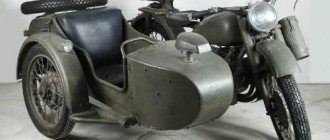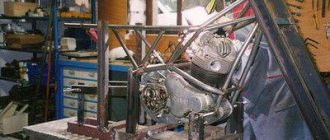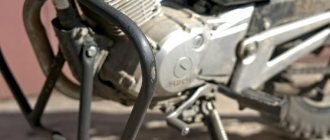The hoverbike is a flying motorcycle that everyone watching Star Wars probably wanted to ride. Similar devices could be seen in all parts of the saga; for example, stormtroopers rode through the forests on them, and you will find a version of the hoverbike from the episode “Rebirth of the Force” in the photo above.
Or perhaps we've watched other science fiction movies where someone floats just an inch off the ground and rolls through futuristic landscapes. Either way, the concept of a car hovering in the air that could take you from point A to point B, or just let you have some fun on the road, was pretty cool!
Time does not stand still, and thanks to the work of a number of futurological engineers, it is already possible to find a working version of a hoverbike. Let's figure out what this vehicle is, how it works and even how much it costs.
Advantages of flying Hoverbike motorcycles
Actually - a flying motorcycle Hoverbike
has a low cost, while it takes up very little space, because it has small dimensions, and therefore can be easily transported by ship or plane to various parts of the globe, can lift impressive loads and transport them to the right place. Moreover, it can also be launched very easily - it does not require a runway or landing strip. Hoverbike flying motorcycles can be used for rescue missions, police as a first responder technique, or when a limited amount of cargo needs to be delivered. The military department is also interested in such devices. Hoverbikes can be used for military reconnaissance, aerial surveillance, some kind of air support during military operations, and also if you need to carry cargo or military personnel through difficult areas.
Chris Malloy himself sees the use of his brainchild - the flying motorcycle Hoverbike - as transport for workers on the ranch.
At first, the amount of $50 thousand was announced to bring Chris Malloy's idea to life, but then users around the world donated much more than $82 thousand for this development. The design of the hoverbike is made in such a way that the device can be placed in a small sports backpack in a few seconds.
This hybrid of a helicopter and a motorcycle still looks more like a modified quadcopter. Now the authors of the Hoverbike say that the model is about to enter real production. The minimum cost of a Hoverbike for project participants will be $1,185. Also, individual radio amateurs can be sold either the frame and components separately, the total cost of which will be approximately $985.
A new project of the Russian company Hoversurf - a flying car SVPP
And now the same Russian development team is now creating a real air taxi, and even with as many as five seats! The name of the startup is VTOL, which is very simply translated, namely, Vertical Take-Off and Landing Vehicle.
The name of the well-known company Hoversurf is now known to many. The company's new project, called the Formula Project (or simply "Formula"), aims to create a flying taxi (namely, a flying car) with many small Venturi turbine engines, which will essentially be the driving force of this flying car. It is also planned to attach folding and unfolding wings to the flying car (depending on movement in the air or on the ground).
Operating principle and design of the flying motorcycle Hoverbike
What is the design of the flying motorcycle Hoverbike? Hoverbike translates as “hovering motorcycle.” That’s right, everything points to the origin of this device from a helicopter. Yes, everything is simple - these are two propellers that force air down and in the middle of them is just a seat. And its operation is reminiscent of the principle of operation of the two-propeller Chinook helicopter, namely, two completely identical propellers dampen the spin and at the same time completely eliminates the need for a special tail rotor. And the flying motorcycle Hoverbike is controlled superbly - just like a real motorcycle, you can select the direction of movement using the most ordinary steering wheel. Gyroscopes help maintain the device's position in the air.
How to prepare a car for transportation by air
In order for a car to be allowed to be loaded on board an aircraft, it must be:
- clean outside and inside;
- with protective car covers;
- with a tank filled with fuel to at least a quarter of its full volume;
- with folded side windows;
- with the battery disconnected and isolated;
- with the handbrake applied in the “park” (for cars with an automatic transmission) or “first gear” (for cars with a manual transmission) selector position.
For air transportation, you need to prepare not only the car, but also the container. For this purpose, a strong frame made of timber is mounted at the bottom of the plywood box, fixing it with stops to the side walls. The car must be installed in the container in such a way that there is no gap between the wheels and the timber frame.
Some transport aircraft have special platforms for securing cars. They are equipped with latches and locks that ensure reliable fastening without the risk of scratching the case. Platforms may have additional protection on the top, bottom and sides.
It is important that all work to prepare the car for the flight is carried out by competent and experienced specialists - only in this case there is a guarantee that:
- the machine will not be damaged during unloading and loading;
- permission for air transportation will be given.
Dimensions of the flying motorcycle Hoverbike
The overall dimensions of the Hoverbike are 1.3 m wide by 3 m (long). Its initial weight (unladen) is 105 kg and it will be capable of lifting an additional 270 kg. On one tank of fuel (30 liters), the device will be able to fly up to 148 km at a speed of up to 148 km/h. At the same time, the Hoverbike, of course, is made of ultra-light materials, namely carbon products and products made of foam filler. And the propeller screws of the flying Hoverbike motorcycle were made of Tasmanian oak. Therefore, as we see, this is an ultra-light flying motorcycle.
Technical characteristics of the created VTOL flying car
And it is planned to use only 52 engines, and 48 of them will be responsible for vertical takeoff and the same landing. The diameter of one such engine is very small and does not exceed 25 cm. “So this is a multicopter!” you say. Yes, this is partly true - this is the number of engines multicopters have, but sometimes there are fewer. Moreover, their number even exceeds the norm that is needed for a normal flight, and if half of their number fails, the airmobile will still take off.
Well, why does such a car need wings? After a strictly vertical take-off, the flying taxi returns to normal flight mode once its wings are fully extended. And they are probably straightening out in the air. Well, if there is a power failure or breakdown, then of course, the wings will allow you to glide for a long time and safely land the device.
And one more significant advantage is that small engines do not create strong and deafening noise, like the same helicopter, for example, or Volocopter.
Maximum height for Hoverbike motorcycle
And although the maximum lifting height of the Hoverbike was stated at the beginning as 3 kilometers, most likely the real height of this device will be just above the treetops. The cost of a real Hoverbike device will be approximately 40 thousand dollars. Of course, it’s hard to imagine crowds of people flying around on such motorcycles at such a rather high stated price, but as an exclusive transport device for individual extreme customers, it’s just right.
“We are combining technologies, we are not developing anything new, but only combining already known technologies - the stability of a motorcycle and the mobility of a helicopter,” said Chris Malloy. It is stated that a pilot's license is not required to operate a Hoverbike.
Take it and wait for a better future
Why hasn't the auto industry switched to covered motorcycles, how much easier would it be to ride and park in the city? Maybe a winged motorcycle is not a solution for congested cities, but only an entertainment vehicle?
Pulse is praised by all its owners. It doesn't roll over and is a lot of fun to drive. They say that balancing with one wheel after a short habit is a good experience. At the same time, the Pulse is safer than any motorcycle because it cannot tip over. It's just dangerous to believe that it can be serviced anywhere outside of your own garage.
When the Pulse launched, it was billed as the car of the future. Maybe this future will come, but it is clearly not soon. Definitely worth seriously considering a purchase like this - an extremely rare classic and future in one - an opportunity like this doesn't come along every day.
Post Views: 1,148
Another video about the flying Hoverbike motorcycle
All materials about aero cars The Terrafugia TF-X flying car may become a reality in 2022. The flying car created in Slovakia is another flying car of the future. Flying car-helicopter PAL-V ONE Cars of the future today, part 6: flight Flying car - I-TEC Maverick buggy Another flying motorcycle - Hoverbike Flying cars in world history, part 1 Flying cars in world history, part 2 Flying cars in the world history, part 3 Flying cars in world history, part 4 Flying cars. Part 5. Modern flying motorcycles Flying cars. Part 6. Modern flying motorcycles, flying boards and bicycles. Flying cars. Part 7. Flying Cossack and magnetic board Flying cars. Part 8. Airbus helicopter and winged Toyota
Almost like an airplane
The designers of this monorail might be fans of Pulse Pulse's absurd sense of humor and satire. However, they started production a long time ago, back in 1982. Then they decided that wings wouldn't be the only reference to airplanes.
The steering wheel of this 5-meter rocket, 4.88 meters high and weighing almost half a ton, can resemble the steering wheel of an airplane. Copies with a round version were also created. Maximum rotation does not require even one full turn. The cabin also closes like the F-14 fighter jet that Pulse owners like to compare their cars to. You just need to close the lid when it rains and push it back when you want to enjoy the sun.
The most obvious link to aviation is, of course, body shape and performance. The tubular frame, covered in fiberglass, looks like a rocket or military jet, if you will. It is important that the pulse is fast. It can reach speeds of over 200 km/h, a lot depends on the engine.
Owners of the motorcycle praise the fun of riding on three wheels, although it lacks the elements of a car.
The price of a hoverbike is the price of safety
The miracle of technology from California will go on sale in 2022. Aerofex has already received a large number of letters from those wishing to pre-order the aircraft. The price of the Aero-X Hoverbike will be around $85,000; it announced the release of a commercial model in 2022 for a price of about $85 thousand. You can pre-order now by depositing $5,000.
A flying motorcycle is a practical thing, because it doesn’t need roads, which means you can conquer endless off-road terrain. There will be no problems coordinating flights because... The maximum lift height will be limited. Controlling a flying motorcycle is intuitive, understandable, and most importantly safe, Aerofex assures. Modern, advanced design makes this device more desirable among people who want to stand out. The founder of the company, and now technical director Mark De Roche, considers getting rid of the “docking effect” a big breakthrough. This will allow people who know how to drive a motorcycle to immediately learn how to operate an Aero-X. Future prototypes will be controlled by the pilot tilting and turning the vehicle using the steering wheel. To prevent future owners, distraught over the purchase, from committing suicide, the device is equipped with systems that limit the speed and altitude. Also, Russian oligarchs will like the idea of adding airbags to the Hoverbike.
Flying skateboard Hendo Hoverboard
This thing from Hendo is a real hoverboard.
Board. Flying. True, they are on magnets and therefore very close to the surface. And not just any one, but a special one – magnetic. This thing was invented by Jill and Greg Henderson from California. They called their technology MFA (Magnetic Field Architecture). The technology took 20 years to develop and was actually the result of a search for a solution that could make buildings more resistant to earthquakes. As a result, the author came up with the idea of using electromagnetic fields to create an “air cushion” between the surface of the earth and the building, capable of completely absorbing destructive vibrations.
Then Henderson realized that the concept could be applied to the field of transportation: similar technology is used in high-speed magnetic levitation trains. To draw attention to his work, he created a floating skateboard from the movie Back to the Future 2.
On Kickstarter they managed to raise more than $500,000 for the project. Unlike the device in the film, Hendo cannot fly over grass and water: it needs an electrically conductive surface. The skateboard works with aluminum and copper, but does not hold up over steel and nickel. Next to the office, Arx Pax, a skate park was built especially for testing, the floor of which is completely covered with copper.
6.Lexus Slide Hoverboard
Photo and video
An Englishman made a Hoverbike with his own hands:
What else you can read:
- Opel Zafira Tourer – Evolution
- Renault Latitude 2022 – A true classic business sedan
- 2022 Porsche Cayenne – A fresh injection will do you some good
- Audi Q5 – “Excellence through technology”
- Mercedes GLK (GLC) 2017-2018 – technical specifications
- Subaru Forester – Off-Road Constellation
- Haval H6 – Compact premium from China.
- Renault Kadjar 2022 – When will it be in Russia?
Bede for Bond
Bede's second project was either a car or a motorcycle called Litestar, which was later renamed Pulse. It attracted attention primarily for its unusual appearance: it looked as if the plane’s wings and tail had been cut off and then released onto the road.
And this was not far from the truth. For example, this is what the Bede BD-5J, which appeared in the James Bond film, looked like:
For obvious reasons, the tail of the car was no longer needed, but the small wings were still preserved. Each of them hid one additional wheel, which was necessary while driving. Litestar never moved on four wheels at the same time: during movement, only three were used - two main ones and one support one. This allowed the Pulse to be classified as a motorcycle.
The most unusual thing happened during the trip. Whereas a normal motorcycle leans when turning in its direction, the Pulse leaned “to the outside” of the turn. This is where the additional wheel came into play, on which either a motorcycle or a car rested.
Why do you still want to call this vehicle a car? The salon at least provided a roof over your head. It could accommodate the driver and passenger one behind the other, and there was also space for small luggage. After all, inside there was a familiar steering wheel (or butterfly steering wheel), as well as quite car seats. The pedals on the floor and the presence of a “windshield wiper” gave it an automotive character. But at heart, Pulse was a motorcycle.
The Pulse came with two engine options. The first was a 400 cc Yamaha engine with about 35 hp. Its power was not enough for the more than 500 kg of the total weight of the Pulse, but in general it was possible to move. True, there was a problem with overheating: the engine, originally designed for installation on an open frame, did not feel the best in a closed box, especially on long trips around the city.
The Honda Goldwing engine was the preferred option. Water cooling solved the problem with overheating, and an increase in volume and an increase in power to 120 hp. made me feel more confident.
Pulse was produced in 1985-1990, during which time about 350 copies hit the roads. Production was curtailed; the reasons for this decision can only be guessed at. But no matter how strange Pulse may seem, it still found its fans. Even now, surviving examples remain serviceable: the fiberglass body is easy to repair, the frame can always be strengthened in the garage, and the engine can be completely replaced at your discretion.
Questions remain only about the uniquely shaped glass and some interior elements, but with access to modern technologies, even this problem becomes more of a problem with an asterisk. And it’s precisely these cars that appear at auctions, and those willing to pay from 16,100 to 57,200 dollars are found one way or another.
Motorcycles in the Automotive Business ad database











